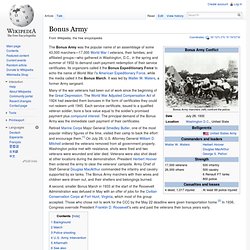

Bonus Army. The Bonus Army was the popular name of an assemblage of some 43,000 marchers—17,000 World War I veterans, their families, and affiliated groups—who gathered in Washington, D.C., in the spring and summer of 1932 to demand cash-payment redemption of their service certificates.

Its organizers called it the Bonus Expeditionary Force to echo the name of World War I's American Expeditionary Force, while the media called it the Bonus March. It was led by Walter W. Waters, a former Army sergeant. Many of the war veterans had been out of work since the beginning of the Great Depression. The World War Adjusted Compensation Act of 1924 had awarded them bonuses in the form of certificates they could not redeem until 1945. Retired Marine Corps Major General Smedley Butler, one of the most popular military figures of the time, visited their camp to back the effort and encourage them.[1] On July 28, U.S.
Background[edit] The Bonus Army: How A Protest Led To The GI Bill. Hide captionIn 1932, a group of WWI veterans in Portland, Ore., rallied the Bonus Army to Washington to lobby for early payment of their promised bonuses.

They set up camp along the Anacostia River that May. But by July, officials lost patience and went into the camp to evict the marchers. It turned violent. A soldier torched a tent, and the Army began torching everything still standing. In 1932, a group of WWI veterans in Portland, Ore., rallied the Bonus Army to Washington to lobby for early payment of their promised bonuses. Occupy Wall Street protests have sprung up in cities across the U.S. — and around the world. It's a form of protest that echoes throughout American history. In 1932, another group of protesters set up encampments and vowed to stay until their voices were heard.
The Bonus Army As World War I drew to a close in 1918, millions of American veterans returned home to the promise of a cash bonus — compensation for their overseas service. Then, the Great Depression struck. Poor People's Campaign. Demonstrators in the Poor People's March at Lafayette Park and Connecticut Avenue in Washington, D.C.

(June 1968) The Poor People's Campaign was a 1968 effort to gain economic justice for poor people in the United States. It was organized by Martin Luther King, Jr. and the Southern Christian Leadership Conference, and carried out in the wake of King's assassination. The Campaign demanded economic and human rights for poor Americans of diverse background. After presenting an organized set of demands to Congress and executive agencies, participants set up a 3000-person tent city on the Washington Mall, where they stayed for six weeks. Purpose[edit] The Poor People’s Campaign was motivated by a desire for economic justice: the idea that all people should have what they need to live. Dr. Development[edit] Idea[edit] The idea for the Poor People’s Campaign began in May 1967 during a SCLC retreat in Frogmore, South Carolina.
Also in August, Senator Robert F. Planning[edit] Publicity[edit] Alcatraz - Indian Occupation/Protest - 1969.